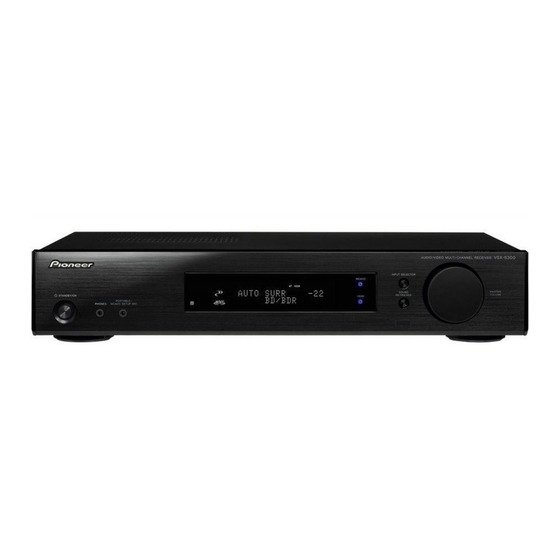Pioneer VSX-S300-k İşletim Araçları - Sayfa 33
Hoparlör Sistemi Pioneer VSX-S300-k için çevrimiçi göz atın veya pdf İşletim Araçları indirin. Pioneer VSX-S300-k 36 sayfaları. Audio/video multi-channel receiver
Ayrıca Pioneer VSX-S300-k için: Hızlı Başlangıç Kılavuzu (33 sayfalar)

Additional information
Chapter 8:
Additional information
Troubleshooting
Incorrect operations are often mistaken for trouble and
malfunctions. If you think that there is something wrong with
this component, check the points below. Take a look at the
other components and electrical appliances being used,
because sometimes the problem may lie there. If the trouble
isn't sorted out even after going through the checks below,
ask your nearest Pioneer authorized independent service
company to carry out repair work.
• If the unit does not operate normally due to external
effects such as static electricity disconnect the power
plug from the outlet and insert again to return to normal
operating conditions.
General
The power does not turn on.
Disconnect the power plug from the outlet, and insert again.
Make sure there are no loose strands of speaker wire touching
the rear panel. This could cause the receiver to shut off
automatically.
The receiver suddenly switches off.
When the Auto Power Down function is working, the power
will automatically turn off if the receiver has not operated for
several hours. Check the setting for the Auto Power Down
function (see The Auto Power Down menu on page 30).
After about a minute (you won't be able to switch the unit on
during this time), switch the receiver back on. If the message
persists, call a Pioneer authorized independent service
company.
The power suddenly turns on or off, or the input suddenly
changes (When the Control with HDMI is ON).
This happens because of the synchronized operation due to
the Control with HDMI function. If synchronized operations
are not needed, set the Control with HDMI to OFF (see HDMI
Setup on page 31).
OVERHEAT shows in the display and the power turns off.
The temperature within the unit has exceeded the allowable
value. Try moving the unit for better ventilation (see page 2).
Lower the volume level.
TEMP shows in the display and the volume level drops.
The temperature within the unit has exceeded the allowable
value. Try moving the unit for better ventilation (see page 2).
Lower the volume level.
No sound is output when an input function is selected.
Use VOL +/– to turn up the volume.
Press MUTE to turn muting off.
Make sure the component is connected correctly (refer to
Connecting your equipment on page 9).
Check the audio output settings of the source component.
Refer to the instruction manual supplied with the source
component.
No image is output when an input function is selected.
Make sure the component is connected correctly (refer to
Connecting your equipment on page 9).
Use the same type of video cables for the source component
and TV to connect to this receiver (see About video outputs
connection on page 12).
Check The Input Assign menu on page 30 to make sure you're
assigned the correct input.
The video input selected on the TV monitor is incorrect. Refer
to the instruction manual supplied with the TV.
No sound from subwoofer.
When using a powered subwoofer, make sure the subwoofer
is switched on.
If the subwoofer has a volume knob, make sure it's turned up.
The Dolby Digital or DTS source you are listening to may not
have an LFE channel.
Switch the subwoofer setting in Speaker Setting on page 28 to
YES or PLUS.
Switch the LFE ATT (LFE Attenuate) on page 25 to 0dB or -5dB.
No sound from surround or center speakers.
Connect the speakers properly (refer to page 10).
Refer to Speaker Setting on page 28 to check the speaker
settings.
Refer to Channel Level on page 29 to check the speaker levels.
The Phase Control feature doesn't seem to have an audible
effect.
If applicable, check that the lowpass filter switch on your
subwoofer is off, or the lowpass cutoff is set to the highest
frequency setting. If there is a PHASE setting on your
subwoofer, set it to 0º (or depending on the subwoofer, the
setting where you think it has the best overall effect on the
sound).
Make sure the speaker distance setting is correct for all
speakers (see Speaker Distance on page 29).
Considerable noise in radio broadcasts.
Connect the antenna (page 14) and adjust the position for
best reception.
Route any loose cables away from the antenna terminals and
wires.
Fully extend the FM wire antenna, position for best reception,
and secure to a wall (or connect an outdoor FM antenna).
Connect an additional internal or external AM antenna
(page 15).
Turn off equipment causing interference or move it away from
the receiver (or move antennas farther away from equipment
causing noise).
Broadcast stations cannot be selected automatically.
Connect an outdoor antenna (refer to page 15).
Noise during playback of a cassette deck.
Move the cassette deck away from your receiver, until the
noise disappears.
No sound is output or a noise is output when software with
DTS is played back.
Make sure the player's settings are correct and/or the DTS
signal out is on. Refer to the instruction manual supplied with
the DVD player.
There seems to be a time lag between the speakers and the
output of the subwoofer.
See Automatically setting up for surround sound (MCACC) on
page 16 to set up your system again using MCACC (this will
automatically compensate for a delay in the subwoofer
output).
After using the Auto MCACC setup, the speaker size setting
(LARGE or SMALL) is incorrect.
Low-frequency noise could have been caused by an air
conditioner or motor. Switch off all appliances in the room and
rerun the Auto MCACC setup.
08
08
33
En
